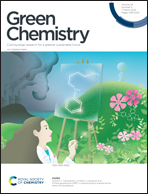Chemical-biological degradation of polyethylene combining Baeyer–Villiger oxidation and hydrolysis reaction of cutinase†
Abstract
Polyethylene is a polyolefin that is widely used in daily life, but its efficient degradation has long been a problem. Compared with physical or chemical methods, techniques for the biodegradation of polyethylene have the advantages of low energy consumption and environmental protection. This study proposes a new method based on Baeyer–Villiger oxidation that generates ester bonds and the hydrolysis reaction of cutinase that degrades them. The first pathway contained UV treatment, immobilized lipase derived from Candida antarctica (CALB) and cutinase derived from Thermobifida fusca WSH03-11 (T. fusca cutinase), and the second contained m-chloroperoxybenzoic acid (mCPBA) and T. fusca cutinase. Both methods can reduce the weight average molecular weight (Mw) of polyethylene. The minimum Mw of the final LDPE was 3862 Da, 47.4% lower than that before treatment with T. fusca cutinase. This study expands on a new method for the degradation of polyethylene by introducing lipase and cutinase to the process for the first time in the literature.



 Please wait while we load your content...
Please wait while we load your content...